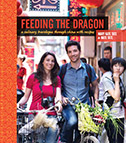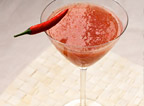fried taro dessert from snow flower and the secret fan

Right now I'm reading Snow Flower and the Secret Fan, a beautiful novel by Lisa See. It's featured on Oprah's book club (which never hurts) and an international bestseller. The first few chapters follow the story of a 7 year old girl in the 1800s as she starts the Chinese footbinding process. The agony and details of which have been difficult for me to stomach. I had no idea that four toes were purposefully broken and folded back up under the foot and big toe. For the rest of the women's lives they could hardly balance to walk or even stand. They spent most of their lives sitting in a "women's room" because they couldn't do much else. During the four hundred or so years that women practiced footbinding in China, the ideal "beautiful" foot was 6 centimeters in length. I've never been so thankful for my big feet.
Anyway! There's a part where the narrator, Lily, then just a little girl, eats her first sugary dessert. "Have you had sugar, Lily?" her friend, Snow Flower, asks. "It is the best thing in the world."
Snow Flower goes on to talk about how Old Man Zuo makes "the best treat in the country" at his stand. Of course I wanted to eat this dessert that Snow Flower calls the best in the world. She goes into detail about how Old Man Zuo makes Fried Taro dessert and I thought I would follow the directions from the book's passage as closely as possible and see what I could come up with. Here's the passage:
"Here's what he does: He fries cubes of taro until they are soft on the inside but firm and crisp on the outside. Then he melts sugar in a big wok over a large fire... He melts it until it turns brown, then he throws the fried taro into the sugar and swirls it around until it is coated. He drops this on a plate and places it on your table, along with a bowl of cold water. You can't believe how hot the taro is with that melted sugar. It would burn a hole in your mouth if you tried to eat it like that, so you pick up a piece with your chopsticks and dip it in the water. Crack, crack, crack! That's the sound it makes as the sugar goes hard. When you bite into it, you get the crunch of the sugar shell, the crispiness of the fried taro, and then the final soft center."
My findings and subsequent Fried Taro dessert recipe:
I got taro (a potato-like root) at a market in Chinatown. An Asian food market is probably your best bet for finding taro. For tips on selecting taro, read this taro post.
As soon as I read this passage I thought fried taro dessert sounded a lot like a northern Chinese dish Nate often makes called Fried Candied Apples. He fries apple wedges with a flour-based batter coated on the outside, then dips them in hot caramelized sugar. They are so hot when they come out, you have to dip them in cold water before eating. This apple dessert is all over China. It's yummy and kind of fun to make and eat. I thought that this Fried Taro dessert might benefit from adding a batter (no offense to Old Man Zuo). I was wrong. I fried it with and without and without is better. Something about adding a batter to the starchy taro felt heavy. It's kind of like fried oreos -- why? -- oreos were doing just fine before people started frying them.
Note: The picture above is of the battered taro version. If you cook our recipe below, yours will look slightly different without the batter coating.
Fried Taro Dessert
1 lbs. taro, peeled and cubed about 1/2 inches
oil for deep-frying
1/2 cup sugar
1 tsp. sesame oil
1 tbs. lard or shortening
Soak taro cubes in a bowl of ice water for 15 minutes (necessary to get the starch out). Drain the taro and pat dry. Heat 2 inches of the oil in a wok over high heat until it is very hot. Add about 10 taro cubes to the oil and fry for 2-3 minutes or until golden brown. Remove the cubes with a strainer and place on paper towels to drain. Fry the remaining taro cubes in this way.
Discard the oil from the wok and put in the sugar, sesame oil, and shortening. Stir the sugar continuously for about 2 minutes or until the sugar caramelizes and turns a light brown then remove the wok from the heat. Use chopsticks to dip each fried taro cube in the caramelized sugar. Place the coated taro cubes on a plate and serve with a small bowl of ice water. Before eating, instruct your guests to use their chopsticks to dunk the taro in the ice water so that the sugar hardens and cools before eating.
-mary kate
 books,
books,  desserts,
desserts,  recipes,
recipes,  vegetables,
vegetables,  vegetarian
vegetarian macanese almond cookies (xing ren bing)

Last night I went to see the free outdoor movie in Bryant Park. HBO screens classic movies on a huge outdoor screen in the park on Monday nights. It's one of my favorite things to do during the summer in New York. Last night the movie was Harold and Maude. My friends and I spread out on a big blanket on the grass below the skyscrapers along with thousands of other people. (Here's a picture I snapped last night.) Somebody brought wine that we drank from classy paper cups and I brought Macanese Almond Cookies, 杏仁餅 (xing ren bing), for everybody to eat while we watched Maude seduce Harold. Maude is 80 years old and Harold is 18 and the whole thing is kind of creepy-- Harold pretends to kill himself 10 different ways-- but it's a comedy and definitely funnier when you're watching it with thousands of other laughing people. We didn't get to the park early enough to get a spot close to the screen and I could hardly hear the dialogue from the speakers but I found the Harold and Maude movie script online on my iPhone and I read along with the movie.
I first ate Macanese Almond Cookies on a trip to Macao. Macao is group of Chinese islands with amazing food about 45 minutes off the coast of Hong Kong by ferry. Macao was settled by Portuguese pirates in the 1500s and the food on the islands is a mixture of mediterranean and Chinese cooking-- imagine Chinese fried rice with olives and Portuguese sausage! Unlike other places in China, restaurants in Macao serve quite a few desserts and there are even European-like cafe's that sell pastries with coffee. These Macanese Almond Cookies are popular with tourists from Hong Kong to bring back as gifts for friends. They are sweet, dry, and grainy (similar to Pecan Sandies or Italian Butter Cookies) and they are made in beautiful wooden moulds that shape the cookie into small jewel-like shapes. I think they are best eaten with tea or wine.
When I made these cookies yesterday, I didn't have a traditional wooden mould to shape the cookies (and I doubt you will either) so I used a small paper cup with the top cut off to be about 1/2" deep. They don't look as ornate as the cookies sold in Macao but they still look and taste pretty great. If you're in New York City from June until August, I definitely recommend checking a movie screening in Bryant Park (Macanese Almond Cookies optional).
-Nate
Macanese Almond Cookies
2 cups mung bean flour
1 cup powdered sugar
1/2 cup ground almonds (about 3/4 cup peeled almonds ground in a food processor)
2/3 cup shortening
1 tsp almond extract
2 tbs water
1/4 cups almonds roughly chopped
1 small paper cup (base of the paper cup should be about a 2" diameter)
Preheat the oven to 275 degrees. Use a sharp knife or a pair of scissors to cut the top portion of the paper cup off, leaving only a 1/2" deep cookie mould. Discard the paper scraps.
In a large mixing bowl mix together the flour, sugar, and ground almonds. Using your hands, mix in the shortening until the dough looks like sand. Add the water and almond extract and continue mixing with your hands until thoroughly mixed.
Place about 5 chopped almond pieces into the paper cup mould. Over the mixing bowl, press a handful of the dough into mould and use your fingers to pack the dough into the mould and then level it off. Place the mould upside-down on an ungreased cookie sheet and slowly remove the mould. Repeat this process with the remaining dough. Bake the cookies for 25 mins and then let them cool for 30 minutes before eating.
chinese truism of the day
Great minds think alike
 chinese truisms
chinese truisms 







